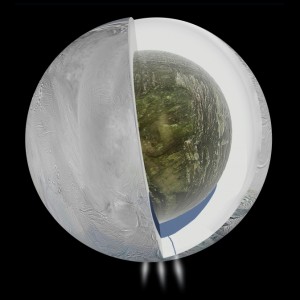Sunday Times 2
Study: Small Saturn moon boasts underground ocean
View(s):CAPE CANAVERAL, Florida (Reuters) – Add Enceladus, a small moon orbiting the giant ringed planet Saturn, to the growing list of places beyond Earth that have oceans – and prospects for hosting life, a study released on Thursday shows.
Situated some 850 million miles (1.3 billion km) away in the outer solar system, icy Enceladus seems an unlikely place for liquid water.
But gravity measurements taken by NASA’s Saturn-orbiting Cassini spacecraft indicate the moon contains an underground ocean in its southern hemisphere. The ocean is believed to be at least as big as Lake Superior, according to research published this week in the journal Science.

Scientists have confirmed an ocean that could support life lies under the surface of Saturn's tiny moon Enceladus (NASA)
Computer models indicate the ocean is likely sandwiched between the moon’s rocky core and its ice-covered surface, said planetary scientist David Stevenson, with the California Institute of Technology.
by Saturn and sister moons on Enceladus.
Cassini previously discovered water plumes jetting out from hot spots in Enceladus’ south pole. Analysis showed the plumes contain salts and organic molecules.
An underground ocean “provides one possible story to explain why water is gushing out of these fractures,” Stevenson said in a statement.
The prospect of liquid water, particularly water that comes close enough to rock to leach out minerals, raises the likelihood that Enceladus has chemistry suitable for life, planetary scientist Jonathan Lunine with Cornell University told reporters on a conference call on Wednesday.
“The interior of Enceladus is a very attractive potential place to look for life,” Lunine said.
Enceladus, which is only about 300 miles (500 km) in diameter, joins Saturn’s large moon Titan and Jupiter’s Europa and Ganymede as places beyond Earth that are likely to contain oceans.
Only Enceladus and Europa, however, show evidence that their oceans are in contact with rock.
To get Enceladus’ gravity maps, scientists had to tease out signals in Cassini’s radio transmissions that changed by just a fraction of a millimeter per second.
The measurements were made as Cassini flew close by Enceladus three times from 2010 to 2012. The flybys showed Enceladus had a different gravitational grip on Cassini depending on whether the spacecraft passed over the moon’s northern or southern hemisphere.
Taking into account what materials are available in the outer solar system – namely rock andice – the scientists then set about running computer models to assess the most likely cause of Enceladus’ asymmetrical gravity.
Their answer: a large ocean about 6 miles (10 kilometres) deep that is covered by 19 to 25 miles (30 to 40 km) of ice
Cassini, which has been studying the Saturn system for a decade, has three more passes by Enceladus before its mission ends in September 2017. No more gravity measurements are slated during those flybys, however.
Scientists are working on follow-on missions proposed for both Enceladus and Europa.
“I don’t know which of the two is going to be more likely to have life. It might be both. It could be neither. I think what this discovery tells us is that we just need to be more aggressive in getting the next generation of spacecraft both to Europa and to the Saturn system once the Cassini mission is over,” Lunine said.


